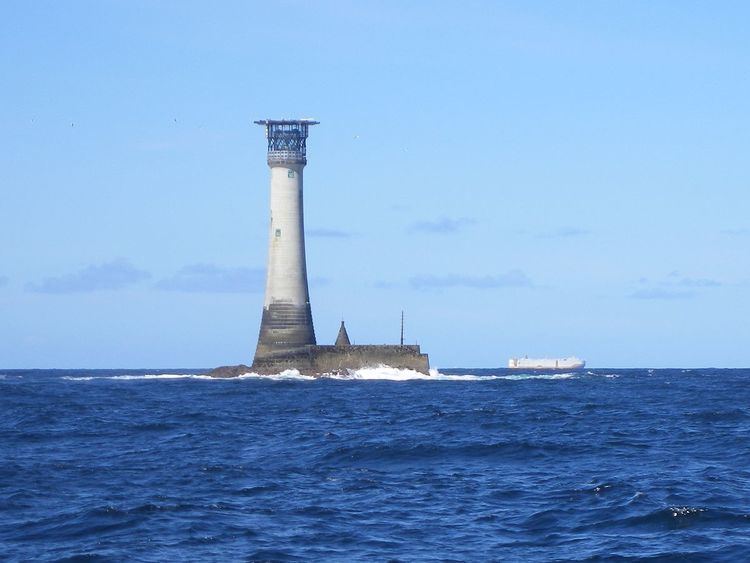Year first constructed 1869 Foundation concrete basement Height 41 m Opened 1869 | Automated 1988 Focal height 34 m (112 ft) Construction started 1861 Fog signal 1 blast every 30s | |
 | ||
Location Land's End
Cornwall
England Tower shape tapered cylindrical tower with lantern and helipad on the top Address Wolf Rock Lighthouse,, United Kingdom Markings / pattern unpainted tower, white lantern Architects James Nicholas Douglass, James Walker Similar Longships Lighthouse, Tater Du Lighthouse, Round Island Light - Isle, Bishop Rock - Isles of Scilly, Land's End | ||
Wolf rock lighthouse 1948
Wolf Rock Lighthouse is on the Wolf Rock, Cornwall, a single rock located 18 nautical miles (33 km; 21 mi) east of St Mary's, Isles of Scilly and 8 nautical miles (15 km; 9.2 mi) southwest of Land's End, in Cornwall, United Kingdom. The fissures in the rock produce a howling sound in gales, hence the name.
Contents
The lighthouse is 41 metres (135 ft) in height and is constructed from Cornish granite prepared at Penzance, on the mainland of Cornwall. It took eight years, from 1861 to 1869, to build due to the treacherous weather conditions that can occur between Cornwall and Scilly. The light can be seen from Land's End by day and night, and is almost exactly halfway between the Lizard and the Isles of Scilly. It has a range of 23 nautical miles (43 km; 26 mi) and was automated in 1988. The lighthouse was the first in the world to be fitted with a helipad.
Wolf rock lighthouse 1952
Geology
Situated between Cornwall and the Isles of Scilly, the Wolf Rock is a small plug of phonolitic lava formed during the early part of the Cretaceous period and is unlike any rock exposed on the Cornish mainland.
History
The Gabrielle of Milford Haven was wrecked on the Wolf Rock in 1394. Her cargo, worth £1000, was washed ashore in Cornwall and collected as wreck.
In 1791 Lt Henry Smith obtained permission from Trinity House to build a navigational mark on the rock. He built a 6.1 m (20 ft) high wrought iron daymark, 10 cm (4 in) in diameter and supported by six stays and a metal effigy of a wolf was placed on top. By 1795 the daymark was washed away. In the late 1830s John Thurburn built a beacon, which was completed on 15 July 1840, and in November of that year was wrecked by storms when the pole and globe on its top were washed away and not replaced until 1842 but they were once more washed away in a storm on 9 October 1844. Trinity House engineer James Walker constructed a 4.3 m (14 ft) high cone-shaped beacon, which took five years to build. Made of iron plates and filled with concrete rubble this was completed in 1848, it can still be seen next to the lighthouse. In July 1861, engineer James Douglass surveyed the rock and Walker started to build the lighthouse the following March, based on Smeaton's third Eddystone Lighthouse. Walker died in October 1862 and James Douglass was appointed engineer-in-chief to the Trinity House, William Douglass, the younger brother of James became resident engineer. Completed on 19 July 1869, the light first shone in January 1870 and in 1879 it was reported that the light flashed red and white. In 1972 it became the first lighthouse in the world to be fitted with a helipad and the lighthouse became automated in July 1988.
The Wolf Rock was the site of a hake (Merluccius merluccius) fishery in the 1870s, especially by fishermen from St Ives with 400 employed in October 1879.
Popular culture
The Wolf Rock Lighthouse features prominently in the classic 1925 Dr Thorndyke detective novel, The Shadow of the Wolf, by R. Austin Freeman.
